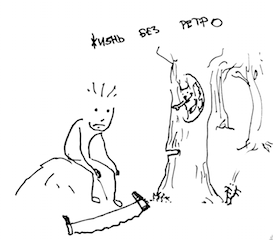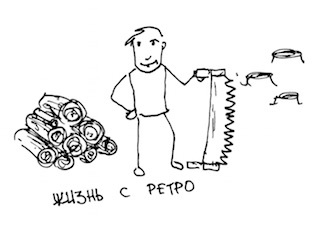Once again about the retrospective

Below is a bit of formalism and bureaucracy for materials on conducting retrospectives, such as Fun Retrospectives . Material information, in the style - "we have so" :)
What is a retrospective
Retrospective (from the Latin. Retrospectare, "look back") - a look into the past, a review of what was in the past. A meeting in which we “sharpen the tools” before the next iteration. If formally, then a retrospective is a team activity revising the closest period of team work in order to improve the process of the work of the same team in the same project.
Retrospective Objectives
- To agree at a special time, how to make the development process even better.
- To solve the problems imposed on the retro and prevent them from recurring.
- Solve problems not only by the team, but also attracting external resources.
What it is worth talking about in retrospectives
- What prevented perform tasks, what were the problems that hinder the productive work of the team.
- What can be changed to work better.
- Sharing successful developments and solved tasks (“See how I can do it!”).
Rules of communication at retrospectives
- Retrospective - for each participant.
- The SCRUM master is the presenter, not the organizer of the retro.
- If it seems to you that your colleague made a mistake, think first about what can be changed in the process so that the person is not mistaken.
- Be active!
Rules for retrospectives
Tasks and Goals
We have adopted a format in which, after discussing a problem or improvement, a “goal” is formed - how we will understand that the problem has been solved or has become better, and the tasks - how we will do to achieve the goal.
Look at the retrospective page, it should not be personal and social goals and objectives. Change them to doable:
- “Vasisualy does the tasks better” - bad! It is necessary: “Fokla checks the Basisualy code and helps it not to release Kaku.”
- “The team keeps an eye on what tasks were called good” - bad! It is necessary: “We make a filter with the names of the tasks and read them on the stand-up, we laugh at the bad ones”.
Training
- Wait for the retro to express the problem - for a long time. It is best to write a comment on the page of the future retrospective or on the board.
- An important element of the retrospective is the embedding of quality. If simply, the next retrospective should begin with activities taken on the retro past.
- To retrospect you need to prepare not only for the scram master, but also for the team.
- The first retro team begins with a clean slate (each team has its own template of retrospectives).
Retrospective itself
- We start the retro! (SCRUM master comes up with a starter)
- We look at the past activities of the retro and make a decision on them - have we done well (on the first retrospective, the teams are empty).
- We consider the comments from the preparation (flipchart, comments to retro, etc.), form “What we can improve” from them.
- We collect more ideas in “What we can improve.”
- We discuss each item from “What we can improve” and form from this specific tasks with those responsible.
- Close the retro!
- We create a new retro page (a new flipchart) so that the team can write down comments at the moment when the idea arose, and not once in the iteration.
')
Starters, closings and methods of collecting ideas are, for example, in retrospective maps that SCRUM masters have.
In some teams, a sprint attendant is appointed, who reminds colleagues of the tasks assigned to them.
Targeted retrospectives
Sometimes we carry out targeted retrospectives, in which case the SCRUM master writes the first topic on the retro topic and the retrospective goal of the comment to the page.
When is a retrospective
The retrospective is conducted by the team after each iteration (usually once every 2 weeks, but maybe more often).
To conduct retrospectives once every 3-4 weeks is difficult and inefficient, we tried. But do not bother you to try.

Source: https://habr.com/ru/post/296500/
All Articles